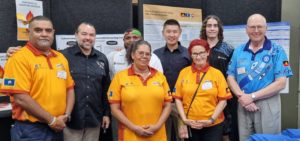This website uses cookies so that we can provide you with the best user experience possible. Cookie information is stored in your browser and performs functions such as recognising you when you return to our website and helping our team to understand which sections of the website you find most interesting and useful.
News
Research targets corneal scarring
New research is aiming to develop a simple, affordable eye drop to reduce the risk of blindness from the infectious eye disease trachoma in remote First Nations communities.
New research is aiming to develop a simple, affordable eye drop to reduce the risk of blindness from the infectious eye disease trachoma in remote First Nations communities.
CERA Research Fellow Dr Yang is investigating the use of a therapeutic protein to prevent corneal scarring that often occurs as a result of trachoma, leading to vision loss and blindness.
Australia remains the only developed country where trachoma occurs. There has been strong progress in the past decade to reduce the spread and prevalence of the disease, but it still occurs in some remote Indigenous communities.
Trachoma is an eye infection caused by the bacterium Chlamydia trachomatis. Repeated infections can lead to the more serious condition trachomatous trichiasis where the eyelid and lashes grow inwards damaging the cornea in the front of the eye.
This chronic inflammation leads to scarring which causes the cornea, the clear window the front of the eye to turn opaque, leading to vision loss and blindness in up to a third of cases.
“Corneal scarring remains a distressing issue for Australian indigenous communities, especially in children and the elderly with trichiasis,’’ says Dr Yang.
“Currently trachoma treatments in remote communities involve providing single dose of antibiotics with no follow up check to see if there is reinfection or if the previous infection caused corneal scarring.’’
“Other treatments, including corticosteroids, can delay wound healing with prolonged use and in severe cases a corneal transplant is the only option to restore sight.
“But transplants can be inaccessible and unaffordable for people living in these remote communities, some indigenous members also do not wish to travel out of their community due to language barrier and lack of family support.
“I want develop a treatment that can be used together with the first dosage of antibiotics and the patient can continue to use by themselves in the form of an eye drop to prevent corneal scarring.’’
Tissue engineering
Dr Yang is using his background in tissue engineering and wound repair to develop the anti-scarring protein therapy, in collaboration with clinical ophthalmologists and biomedical scientists.
He says that so far, pharmaceutical agents in development have only focused on treating infections and none can improve wound healing while suppressing scarring.
“This means too many people in remote areas go blind or struggle to afford the travel required for a corneal transplant,’’ he says. “Follow up care is also difficult.”
“I want to provide an alternative that can prevent having to take someone out of their community. It would also be affordable and non-invasive.”
CERA Innovation Fund
To support his research, Dr Yang has received seed funding from the CERA Innovation Fund to investigate the naturally produced human protein, which is already available.
“The protein I’ve been looking at actually specifically targets the pathway through which scarring occurs,” he says. “It’s been shown to play a positive role in a different tissue in preclinical trial … and now we’re trying to validate its effectiveness in the cornea, which has very similar structural properties.”
Dr Yang has conducted preliminary tests on human corneal cells in the lab with the support of Professor Greg Dusting and Professor Mark Daniell. So far, the results have been extremely promising.
The unpublished findings were presented at the 2022 National Aboriginal and Torres Strait Islander Eye Health Conference in Darwin.

From L-R front row: Walter Bathern, Lesley Martin, Fiona Lange and Professor Hugh Taylor AC from the University of Melbourne’s Indigenous Eye Health (IEH) unit.
From L-R back row: Shaun Tatipata, Deadly Enterprises; Jovian Dalywater, Indigenous Allied Health Australia (IAHA); Dr Yang, CERA and Gabe Oth, IAHA.
Next steps
Dr Yang now hopes to secure more funding to further test the protein’s anti-scarring properties. He says if it is effective, its ready availability could reduce the time needed to develop an eye drop.
If effective, this could provide a simple, non-invasive treatment for all patients, including those in remote areas and in developing nations where trachoma is more prevalent.
And while, the ultimate aim remains to eliminate trachoma completely around the world – the protein could have broader potential to prevent or even treat corneal scarring caused by other conditions such as keratitis, corneal injury or following corneal transplants.
Dr Yang hopes to further validate the protein’s properties in the laboratory and preclinical trials.
“We are also working with pharmacological scientists to formulate the eyedrop to prolong its shelf-life, which will ultimately make the therapeutic protein a suitable product for remote Indigenous
communities.”
- Dr Yang’s research is supported by the CERA Innovation Fund and Royal Victorian Eye and Ear Hospital Corneal Unit.

